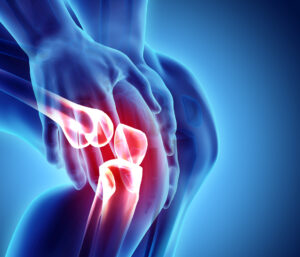
You use your knees for sitting, standing, and walking. When you experience pain and weakness in your knees, you will lose the ability to perform many of the activities essential to independent life.
Your disabilities may prevent you from earning a living. Even if you have a desk job, sitting comfortably may become impossible. You might not have the strength or flexibility to perform essential activities like driving, cleaning, or showering.
What Is the Structure of Your Knees?

Your knees form the joint between your thighs and calves. This joint allows you to sit, stand, and walk by providing a pivot point in the middle of your leg.
Four bones meet in your knee. Your femur runs from your knee to your hip. It transfers your weight from your pelvis to your tibia.
Your lower leg contains two bones. The tibia bears the load transferred from the femur. The tibia connects to your ankle and foot. The fibula is not a load-bearing bone. Instead, it stabilizes your lower leg by connecting your knee to your ankle.
The patella, or kneecap, sits over your knee. It protects the knee joint.
Ligaments hold your skeleton together. You have five ligaments in your knee:
- The anterior cruciate ligament (ACL) runs from the front of the tibia to the middle of the femur
- The posterior cruciate ligament (PCL) runs from the back of the tibia to the middle of the femur
- The medial collateral ligament (MCL) connects the medial side of the femur to the tibia
- The lateral collateral ligament (LCL) connects the lateral side of the femur to the fibula
- The patellar ligament holds the patella to the tibia
If you follow sports, you have probably heard of these ligaments since athletes can suffer season-ending injuries when these ligaments tear. These ligaments also guide the movement of the knee. For example, the ACL guides your tibia as it moves forward, while the PCL guides it during backward movement.
Cartilage material lines the surfaces of the tibia and femur. The cartilage provides a smooth, tough surface so the leg bones do not wear. Cartilage also has a springy texture that cushions the knee joint.
What Can Cause a Knee Injury?
Knee injuries result from three types of trauma:
Hyperextension
Hyperextension is a very common cause of knee injuries. Hyperextension happens when your knee bends too far or bends in the wrong direction. The soft tissues in the knee can get torn when the knee hyperextends.
Hyperextension injuries can happen when playing sports. They can also happen in slip and fall accidents. When you lose your footing, your weight can force your knee to bend the wrong way, hyperextending it.
Blunt Injuries
When you hit your knee, you suffer a blunt injury. These injuries can happen in falls. But another common cause of blunt knee injuries is car accidents. When your body whips around during a car crash, you can strike your knee on the door, console, or the underside of the dashboard.
Penetrating Injuries
Penetrating injuries occur when something pierces your knee. This could happen in a workplace accident if you fall onto something sharp like a tool or nail. Pedestrian or bicycle accidents can also cause penetrating knee injuries when you fall onto the road and hit your knee on a rock or piece of glass.
What Are Some Examples of Knee Injuries?
Knee injuries can take many forms, including:
Bruised Knee
A bruised knee happens when blunt trauma ruptures blood vessels under the skin. You will experience skin discoloration, pain, and swelling in the injured area. Bruises usually heal within a few days.
Sprained Knee
Hyperextension trauma can sprain the ligaments of your knee. Sprained ligaments have tears in them. If the tears are small, you might recover in four to six weeks with rest. If you suffer a full-thickness tear of a knee ligament, you may require surgery. After surgery, you could require several months of rest and rehabilitation to recover.
Common symptoms of a sprained knee include:
- Knee pain
- Joint stiffness and inflammation
- Bruises
- Popping sound at the time of the injury
Treatment for a sprained knee may require immobilization using a brace. The brace supports the knee and prevents you from moving the joint until it heals.
Torn Cartilage
Hyperextension or penetrating trauma can tear the cartilage lining the joint. This causes two problems. First, torn cartilage can float freely inside the knee and interfere with your knee motion. When this happens, a doctor may perform surgery to remove the loose pieces of cartilage.
Second, cartilage protects the leg bones from grinding. When the knee cartilage tears, you may experience bone-on-bone grinding that causes pain and inflammation. This grinding can also lead to arthritis later in life.
Cartilage cannot heal itself because it lacks blood supply. As a result, treatment for your torn cartilage may include rest and physical therapy to prepare you for your long recovery.
Fractured Patella
A fractured patella usually happens because of blunt trauma. A powerful impact on your kneecap can shatter the patella into multiple pieces. In most cases, doctors can rebuild the patella using screws and plates. But occasionally, doctors will remove the patella without repairing or replacing it.
How Can You Get Compensation for a Knee Injury?
You can pursue personal injury compensation if someone else’s actions damaged your knee. To recover compensation, you must show the other party acted negligently and that negligence caused your injury.
Negligence means that the other person failed to exercise reasonable care. You will prove this by showing that they knew or should have known that their actions were unreasonably dangerous. For example, a driver who runs a stop sign and hits your vehicle probably acted negligently.
Knee injuries can produce lifelong pain, stiffness, and weakness. To learn about the compensation you can recover for a knee injury, Give Baggett Law Personal Injury Lawyers a call at (904) 396-1100 for a free consultation.




